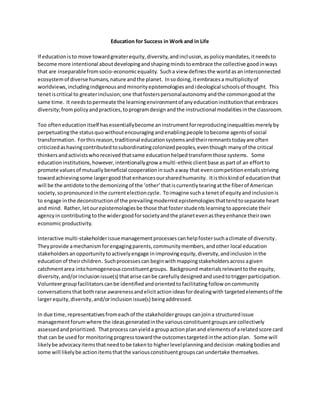
Education for Success in Work and in Life
- 1. Education for Success in Work and in Life If educationisto move towardgreaterequity,diversity,andinclusion,aspolicymandates,itneedsto become more intentional aboutdevelopingandshapingmindstoembrace the collective goodinways that are inseparablefromsocio-economicequality. Sucha view definesthe worldasaninterconnected ecosystemof diverse humans,nature andthe planet. Insodoing,itembracesa multiplicityof worldviews,includingindigenousandminorityepistemologiesandideological schoolsof thought. This tenetiscritical to greaterinclusion;one thatfosterspersonalautonomyandthe commongoodat the same time. It needstopermeate the learningenvironmentof anyeducationinstitutionthatembraces diversity;from policyandpractices,toprogramdesign andthe instructional modalitiesinthe classroom. Too ofteneducationitself hasessentiallybecome aninstrumentforreproducinginequalitiesmerelyby perpetuatingthe statusquowithoutencouragingandenablingpeople tobecome agentsof social transformation. Forthisreason,traditional educationsystemsandtheirremnantstodayare often criticizedashavingcontributedtosubordinatingcolonizedpeoples,eventhough manyof the critical thinkersandactivistswhoreceivedthatsame educationhelpedtransformthose systems. Some educationinstitutions,however,intentionallygrow amulti-ethnicclientbase aspartof an effort to promote valuesof mutuallybeneficial cooperationinsuchaway that evencompetitionentailsstriving towardachievingsome largergood thatenhancesoursharedhumanity. Itisthiskindof educationthat will be the antidote tothe demonizingof the ‘other’thatiscurrentlytearingatthe fiberof American society,sopronouncedinthe currentelectioncycle. Toimagine sucha tenetof equityandinclusionis to engage inthe deconstructionof the prevailingmodernistepistemologiesthattendtoseparate heart and mind. Rather,letourepistemologiesbe those thatfosterstudentslearningtoappreciate their agency in contributingto the widergoodforsocietyandthe planetevenastheyenhance theirown economicproductivity. Interactive multi-stakeholderissuemanagementprocessescanhelpfostersuchaclimate of diversity. Theyprovide amechanismforengagingparents,communitymembers,andother local education stakeholders anopportunitytoactivelyengage inimprovingequity,diversity,andinclusion inthe educationof theirchildren. Suchprocessescan beginwith mappingstakeholdersacross agiven catchmentarea intohomogeneousconstituentgroups. Background materialsrelevanttothe equity, diversity,and/orinclusionissue(s) thatarise canbe carefullydesignedandusedtotriggerparticipation. Volunteergroupfacilitatorscanbe identifiedandorientedtofacilitating follow oncommunity conversations thatbothraise awarenessandelicitactionideasfordealingwith targetedelements of the largerequity,diversity,and/orinclusionissue(s) beingaddressed. In due time, representativesfromeachof the stakeholdergroups canjoina structuredissue managementforumwhere the ideasgeneratedinthe variousconstituentgroupsare collectively assessedandprioritized. Thatprocess canyield a groupaction planand elementsof arelatedscore card that can be usedfor monitoringprogresstowardthe outcomestargetedinthe actionplan. Some will likelybe advocacyitemsthatneedtobe takento higherlevelplanninganddecision-makingbodiesand some will likelybe actionitemsthatthe variousconstituentgroupscanundertake themselves.
- 2. A greatby-productof such communityengagementprocessesistheirpowertogenerate supplementary after-school orhome-basedlearningactivitiesthatonlyfurtherimprovelearningoutcomes. Considerableprogresshasbeenmade inrecentyearsinbringingclarityaround the wholeareaof life skillsinstruction,particularlyintermsof operationalizing social-emotional lifeskillsdevelopmentor whathas recentlybeenpopularizedas emotional intelligence (EQ). Social-emotional skillsare now commonlygroupedintothe fourdomainsof self-awareness,self-management,socialawarenessand relationshipmanagement. Ithas become clearthatskillssuchas these are bestlearned,notinthe abstract, butin the contextof some otheractionlearningendeavor. Theyare,bynature,all abouthow the studentmanages external socialrelationshipsandinternal emotionalresponsesinthe course of participatinginsomethingelse the largergroupisdoingor learningtogether. The twoare tightly interwovenbutnocourse need focusexclusivelyonsuchlife skillsinisolation. Whatiscritical isthat learnershave opportunity topause andreflectinthe midstof otheractionlearningactivities onwhat theyare feelingand onwhatis happeninginhow theyare relatingtoothersinthe group. Of course the teachersor facilitatorsleadingtheseintegratedactivitiesmust themselves have beenon the same journeyof becomingaware of theiremotionsandwhat’sgoingonintheirsocial relationships and,basedon that, howto manage them. Giventhatis a continuum, itmaybe helpful toofferstaff an opportunitytoengage insome actionlearningformof professional developmentthathelps them continue to buildtheirownsocial emotional skills. Recentresearchfindingsconfirmthat90% of topperformersare highinemotional intelligence. EQis twice as importanttosuccessin life asIQ. IQ is largely staticbutEQ can be increased. EQisso critical to successthat itaccounts for 58% of performance inall typesof jobs. It’sthe single biggestpredictorof performance inthe workplace andthe strongestdriverof leadershipandpersonal excellence. Many Fortune 500 companies nowprovide life coachestoseniorexecutivestostrengthencritical social skills; skillsthatare oftenneglectedineducationsystemswherecognitive skillsare prioritizedoversocial emotional skill development. What is interestinghere isthatcompaniestodayare tryingtoclose this gap because theyhave learnedthatitultimately affectstheirbottomline. At the same time,evidence hasemergedthatimprovingsocial emotional skillsdirectlyimpacts academicperformance as well. Itisfor thisreason,then,thatsocial-emotional learning, already embracedincuttingedge schools,isincreasinglybeingincorporatedintopublicschool systemsacross the country as well. Notsurprisingly,equity,diversity,andinclusionthriveincontextswhere social- emotional learningisinfocus. The greaterthe diversitythe greaterthe opportunityforpersonal developmentandgrowth;growththat ultimatelyleadstogreatersuccessinthe workplace. Because the culturesof manyminoritiesfocusmore heavilyonthe collectivewholeasopposedtopersonal autonomy,learninginstitutionsthatfosterequity,diversity,andinclusionhave areadyfoundationfor buildingsocial emotional life skillsalongside otherlearningpriorities. Improvingequity,increasingdiversity,andexpandinginclusionentailsembracingmultiple intelligences and limitingthe dependenceontextbooks,lectures,andworksheetsasthe primarymeansof delivering the basic skillsstudentsneedtosucceed. Traditional educationtendstohonorthe highlyarticulateor logical people of ourculture atthe expense of those whoare giftedin otherintelligences;viz.,spacial
- 3. intelligence,bodily-kinestheticintelligence,musical intelligence,interpersonal intelligence, intrapersonal intelligence,ornaturalistintelligence. Unfortunately,manystudents stronginone or more of these intelligences receivelittle reinforcementfortheminschool. They may,infact, endup beinglabeled‘learningdisabled’,‘ADD’(attentiondeficitdisorder),orsimplyunderachievers,whentheir unique ways of thinkingandlearningare overlooked inclassroomsheavilybiasedinfavorof linguisticor logical-mathematical learningstyles. The neteffect,however, isthatthe classroombecomes impoverishedtothe degree thatthe learningexcludesthe contibutions of those withother intelligences. Farbetter,then,todesignlearningexperiencesthatcaterto multiple intelligences; utilizinglearningstylesthat incorporate music,cooperative learning,artactivities,roleplay,multimedia, fieldtrips, peergroupinteraction, innerreflection, mentorinteraction, journaling, etc., aswell asthe more familiar“chalkandtalk’methodsof deliveringclassroominstruction. Reducingachievementgapsforstudentsfromlow income orcultural minorityfamiliesoften requires improvingreadingfluencyandcomprehensionskills. New modelsforimprovingreadingfluency are nowavailable thatinvolvestructuredwaysof pairingslowerreaderswithbetterreadersininteractive exercisesthatcompel studentstoremodel the neuralnetworkthat,inpoorreaders,guidesthe reading processincorrectly.Once remodeled,the networkyieldscomfortable,natural readingand understandingof the author’smessage everytime itisaccessed. These waysof improvingreading fluencyandcomprehensionrely lessonlinguisticandlogical intelligence thando the methodsneeded for the initial learningof sounds,letters,andsyllables. And,like social emotional learning,improving readingfluencyandcomprehensionismosteffectivewhenitislinkedtoothercontentor activities that are part of the studentswiderintegratedlearningexperience. The most fundamental of educationgoalsare fluentreadingskills,financialliteracyskills,andsocial emotional managementskills. Mixinglearningstylestoinclude actionmethods suchasstructured buddyreadingand interactive savingsgroups,all withperiodicmomentsof reflectiononsocial emotional responses,canleadtolearninggainsthatapplyacross thisbasicskill set.